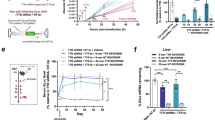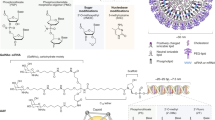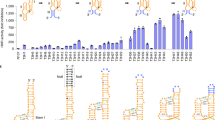Abstract
Plasmid expression cassette design must include a thoughtful analysis of potentially every nucleotide comprising a covalently closed circular or end-protected linear DNA. This review will discuss recent studies in unraveling the mechanisms of postdelivery gene silencing, codon optimization and promoter identification. The recent discovery of potent RNA interference (RNAi) mechanisms for sequence-specific gene silencing has also invoked a great deal of interest in development of expression cassettes that can produce double-stranded RNA molecules for RNAi. Expression cassettes based on both RNA polymerase II and polymerase III transcription units that generate double-stranded RNA molecules for RNAi will also be discussed.
This is a preview of subscription content, access via your institution
Access options
Subscribe to this journal
Receive 12 print issues and online access
$259.00 per year
only $21.58 per issue
Buy this article
- Purchase on Springer Link
- Instant access to full article PDF
Prices may be subject to local taxes which are calculated during checkout


Similar content being viewed by others
References
Niidome T, Huang L . Gene therapy progress and prospects: nonviral vectors. Gene Therapy 2002; 9: 1647–1652.
Garmory HS, Brown KA, Titball RW . DNA vaccines: improving expression of antigens. Genet Vaccines Ther 2003; 1: 2.
Rodriguez EG . Nonviral DNA vectors for immunization and therapy: design and methods for their obtention. J Mol Med 2004; 82: 500–509.
Roth CM, Sundaram S . Engineering synthetic vectors for improved DNA delivery: insights from intracellular pathways. Annu Rev Biomed Eng 2004; 6: 397–426.
Stacey KJ et al. The molecular basis for the lack of immunostimulatory activity of vertebrate DNA. J Immunol 2003; 170: 3614–3620.
Chevalier-Mariette C et al. CpG content affects gene silencing in mice: evidence from novel transgenes. Genome Biol 2003; 4: R53.
Chen ZY, He CY, Meuse L, Kay MA . Silencing of episomal transgene expression by plasmid bacterial DNA elements in vivo. Gene Therapy 2004; 11: 856–864.
Trinh R, Gurbaxani B, Morrison SL, Seyfzadeh M . Optimization of codon pair use within the (GGGGS)3 linker sequence results in enhanced protein expression. Mol Immunol 2004; 40: 717–722.
Available from Dr George Gutman, University of California, Irvine, CA, 92697. gagutman@uci.edu.
Gao W et al. UpGene: application of a web-based DNA codon optimization algorithm. Biotechnol Prog 2004; 20: 443–448.
Trinklein ND, Aldred SJ, Saldanha AJ, Myers RM . Identification and functional analysis of human transcriptional promoters. Genome Res 2003; 13: 308–312.
Marino-Ramirez L, Spouge JL, Kanga GC, Landsman D . Statistical analysis of over-represented words in human promoter sequences. Nucleic Acids Res 2004; 32: 949–958.
Malo MS et al. Improved eukaryotic promoter-detection vector carrying two luciferase reporter genes. Biotechniques 2003; 35: 1150–1154.
Finn J, Lee AC, MacLachlan I, Cullis P . An enhanced autogene-based dual-promoter cytoplasmic expression system yields increased gene expression. Gene Therapy 2004; 11: 276–283.
Hannon GJ . RNA interference. Nature 2002; 418: 244–251.
Caplen NJ . Gene therapy progress and prospects. Downregulating gene expression: the impact of RNA interference. Gene Therapy 2004; 11: 1241–1248.
Coburn GA, Cullen BR . siRNAs: A new wave of RNA-based therapeutics. J Antimicrob Chemother 2003; 51: 753–756.
Clayton J . The silent treatment. Nature 2004; 431: 599–605.
Wagner E . Strategies to improve DNA polyplexes for in vivo gene transfer: will ‘artificical viruses’ be the answer? Pharm Res 2004; 21: 8–14.
Wells DJ . Gene therapy progress and prospects. Electroporation and other physical methods. Gene Therapy 2004; 11: 1363–1369.
Schramm L, Hernandez N . Recruitment of RNA polymerase III to its target promoters. Genes Dev 2002; 16: 2593–2620.
Brummelkamp TR, Bernards R, Agami R . A system for stable expression of short interfering RNAs in mammalian cells. Science 2002; 296: 550–553.
Paddison PJ et al. Short hairpin RNAs (shRNAs) induce sequence-specific silencing in mammalian cells. Genes Dev 2002; 16: 948–958.
Sui G et al. A DNA vector-based RNAi technology to suppress gene expression in mammalian cells. Proc Natl Acad Sci 2002; 99: 5515–5520.
Paul CR, Good PD, Winer I, Engelke DR . Effective expression of small interfering RNA in human cells. Nat Biotech 2002; 20: 505–508.
Yu JY, DeRuiter SL, Turner DL . RNA interference by expression of short-interfering RNAs and hairpin RNAs in mammalian cells. Proc Natl Acad Sci 2002; 99: 6047–6052.
Miyagishi N, Taira K . U6 promoter-driven siRNAs with four uridine 3′ overhangs efficiently suppress targeted gene expression in mammalian cells. Nat Biotech 2002; 19: 497–500.
Lee NS et al. Expression of small interfering RNAs targeted against HIV-1 rev transcripts in human cells. Nat Biotech 2002; 19: 500–505.
Tran N, Cairns MJ, Dawes IW, Arndt GM . Expressing functional siRNAs in mammalian cells using convergent transcription. BMC Biotechnol 2003; 3: 21.
Kaykas A, Moon RT . A plasmid-based system for expressing small interfering RNA libraries in mammalian cells. BMC Cell Biol 2004; 5: 16.
Xia XG et al. An enhanced U6 promoter for synthesis of short hairpin RNA. Nucleic Acid Res 2003; 31: e100.
Matsukura S, Jones PA, Takai D . Establishment of conditional vectors for hairpin siRNA knockdowns. Nucleic Acids Res 2003; 31: e77.
Czauderna F et al. Inducible shRNA expression for applications in a prostate cancer mouse model. Nucleic Acids Res 2003; 31: e127.
van de Wetering M et al. Specific inhibition of gene expression using a stably integrated, inducible small-interfering-RNA vector. EMBO Rep 2003; 4: 609–615.
Gupta S et al. Inducible, reversible, and stable RNA interference in mammalian cells. Proc Natl Acad Sci 2004; 101: 1927–1932.
Cullen BR . Derivation and function of small interfering RNAs and microRNAs. Virus Res 2004; 102: 3–9.
Bartel DP . MicroRNAs: genetics, biogenesis, mechanism, and function. Cell 2004; 116: 281–297.
Lee Y et al. MicroRNA genes are transcribed by RNA polymerase II. EMBO J 2004; 23: 4051–4060.
Zeng Y, Wagner EJ, Cullen BR . Both natural and designed micro RNAs can inhibit the expression of cognate mRNAs when expressed in human cells. Mol Cell 2002; 9: 1327–1333.
Zeng Y, Cullen BR . Sequence requirements for micro RNA processing and function in human cells. RNA 2003; 9: 112–123.
Krol J et al. Structural features of microRNA (miRNA) precursors and their relevance to miRNA biogenesis and small interfering RNA/short hairpin RNA design. J Biol Chem 2004; 279: 42230–42239.
Author information
Authors and Affiliations
Rights and permissions
About this article
Cite this article
Ill, C., Chiou, H. Gene Therapy Progress and Prospects: Recent progress in transgene and RNAi expression cassettes. Gene Ther 12, 795–802 (2005). https://doi.org/10.1038/sj.gt.3302524
Published:
Issue Date:
DOI: https://doi.org/10.1038/sj.gt.3302524
Keywords
This article is cited by
-
A novel gene therapy strategy using secreted multifunctional anti-HIV proteins to confer protection to gene-modified and unmodified target cells
Gene Therapy (2014)
-
An HDAC inhibitor enhances cancer therapeutic efficiency of RNA polymerase III promoter-driven IDO shRNA
Cancer Gene Therapy (2013)
-
A bidirectional promoter architecture enhances lentiviral transgenesis in embryonic and extraembryonic stem cells
Gene Therapy (2011)
-
Minimal doses of a sequence-optimized transgene mediate high-level and long-term EPO expression in vivo: challenging CpG-free gene design
Gene Therapy (2011)
-
Generation of Cell Lines to Complement Adenovirus Vectors using Recombination-Mediated Cassette Exchange
BMC Biotechnology (2010)



